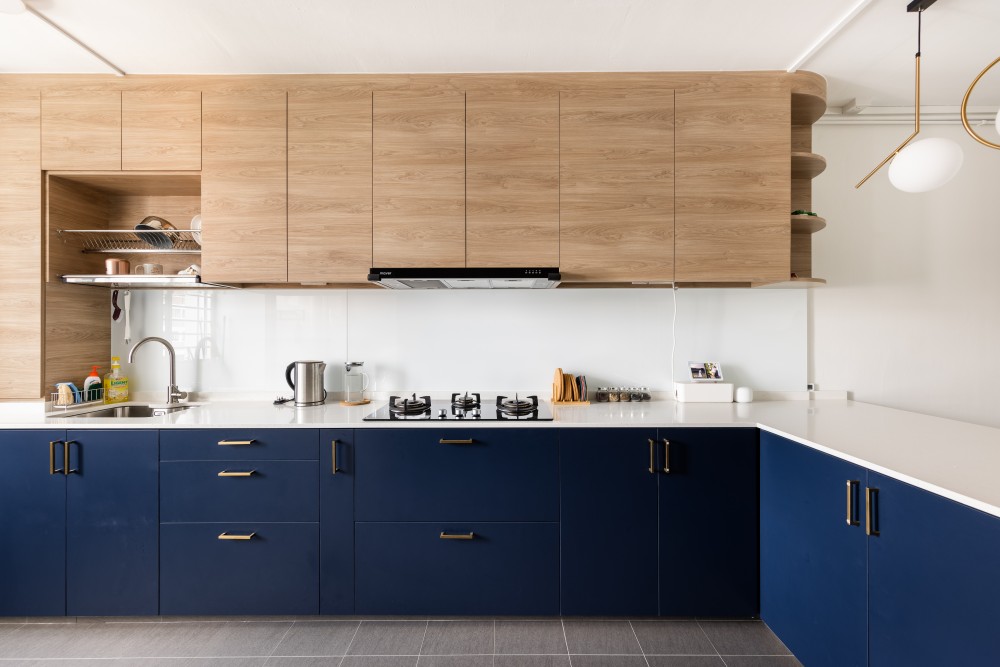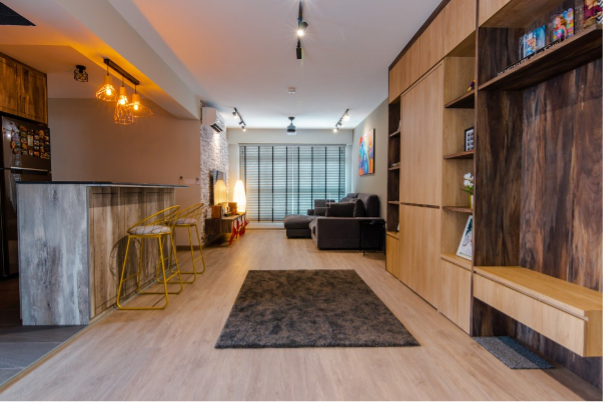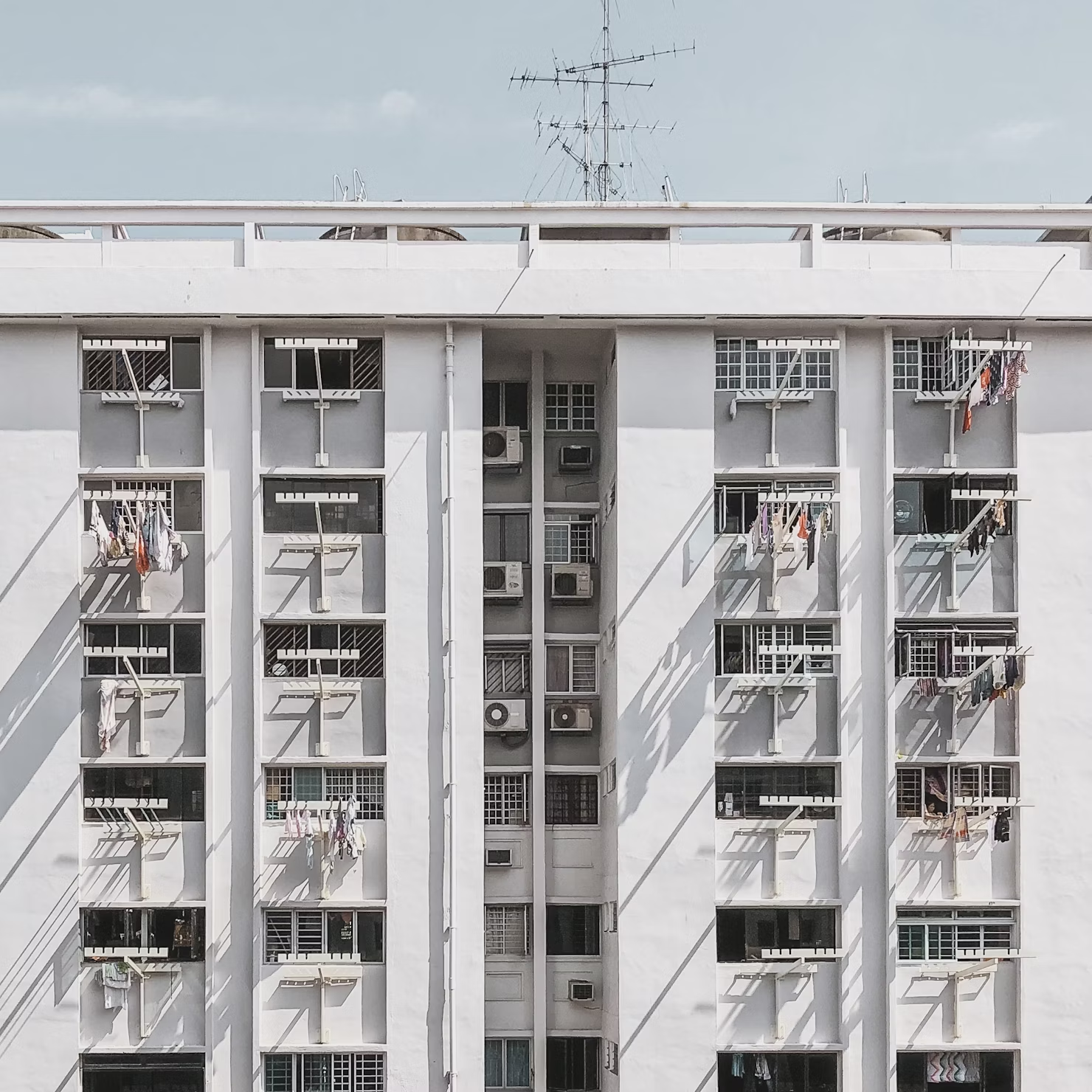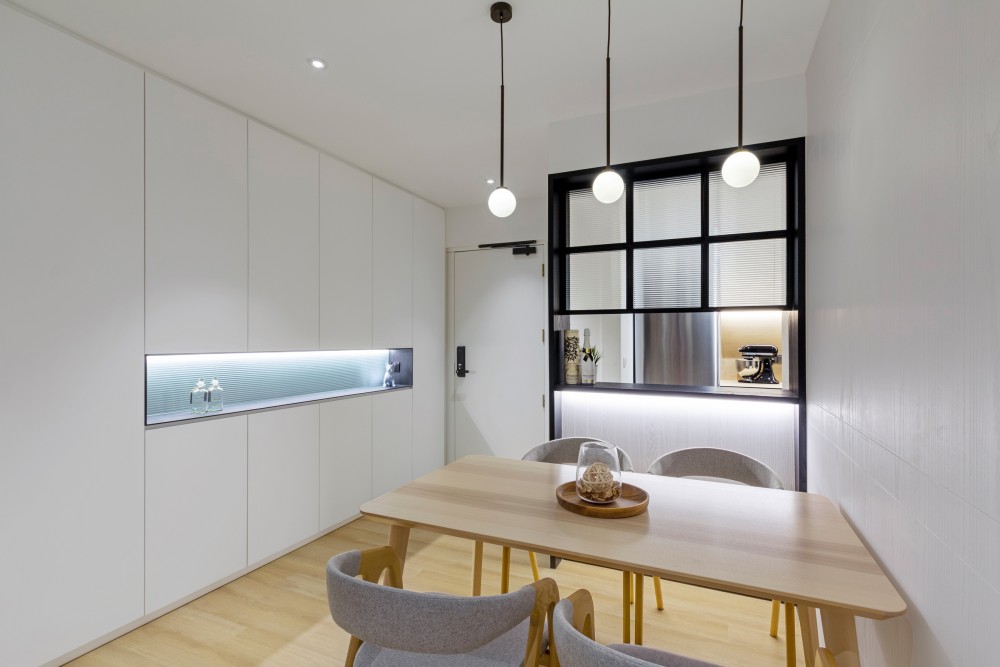The Ultimate Guide to Renovating In the Minimalist Style
Minimalism is both a design aesthetic, and a lifestyle movement that values simplicity, functionality, and beauty.
In Singapore, where space is often a luxury, adopting a minimalist approach to renovation can help create a home that feels open, serene, and timeless.
In this guide, you’ll learn everything you need to know about renovating in the minimalist style, tailored specifically for Singapore homes.
Understanding Minimalism in the Singapore Context
At its core, minimalism is about “less is more.” This philosophy emphasizes clean lines, uncluttered spaces, and a focus on quality over quantity. By stripping away excess and prioritizing essentials, minimalism creates a serene, visually harmonious environment that feels calming yet purposeful.
For Singapore homes, where limited floor space is often a concern, this approach holds particular appeal. A minimalist design can make even the smallest HDB or condominium unit feel open and spacious by eliminating unnecessary furniture and decor. It prioritizes functionality, ensuring that every piece serves a purpose, whether it’s providing storage, enhancing comfort, or adding aesthetic value.
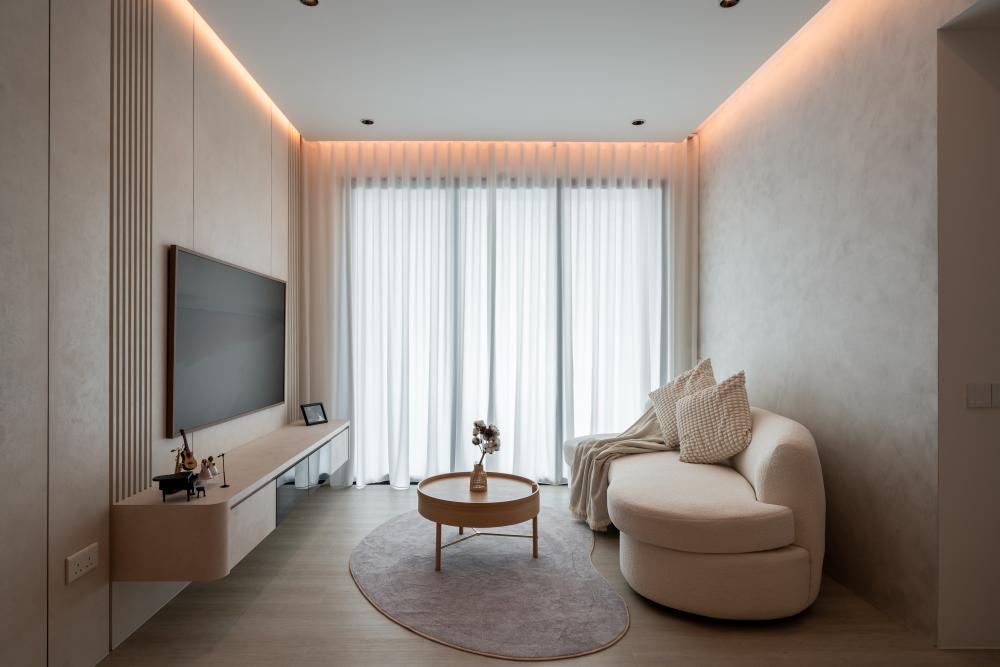

Treasure at Tampines 6 ($75,000) by Design 4 Space Pte Ltd
However, achieving minimalism in a Singaporean context comes with its own set of challenges.
Working within HDB regulations may limit certain design choices, such as hacking walls or modifying structural elements. Additionally, homeowners need to balance aesthetics with practicality, ensuring the space meets the demands of everyday living, especially in compact units or multi-generational homes.
The key is to strike a delicate balance between simplicity and livability, tailoring the design to fit the unique constraints and lifestyle needs of the local context.
What Minimalism Isn’t
Minimalism is often misunderstood as simply throwing together white furniture with clean lines and calling it a day.
While minimalism does emphasize simplicity, it’s far from being just about sparse interiors or monochromatic palettes. In its purest form, minimalism is a design philosophy rooted in intentionality and functionality, often involving high-quality materials and meticulous craftsmanship.
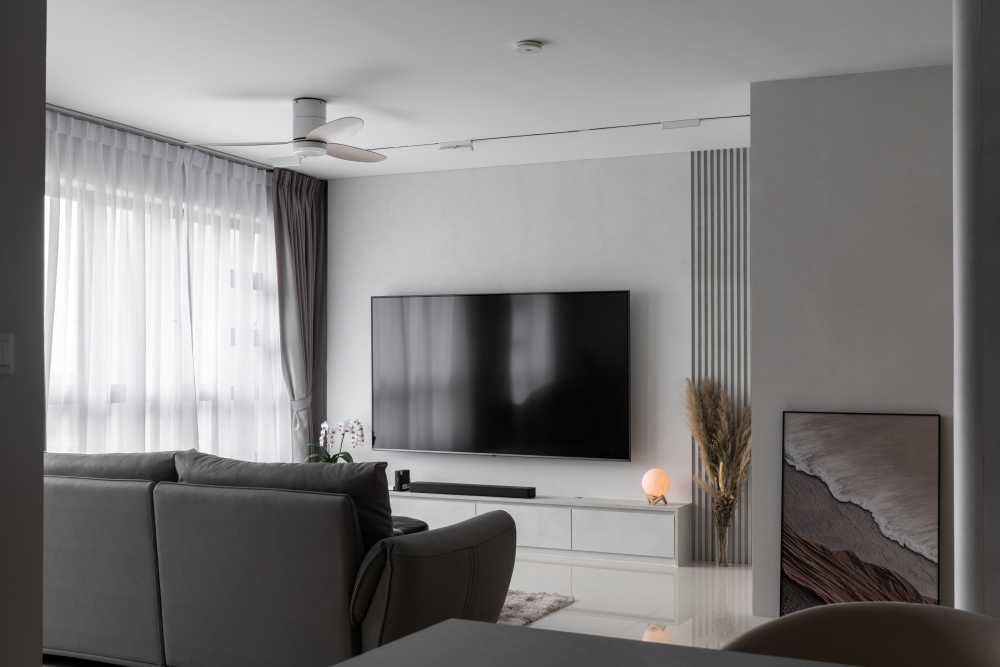

Tampines Greenvines 3 ($80,000) by Design 4 Space Pte Ltd
At first glance, minimalism might seem like a budget-friendly option. However, traditional minimalism can be surprisingly expensive. The focus on precision and quality often comes with a hefty price tag. Here are some common elements often utilized in minimalist homes, along with the reasons why they can be more costly:
Seamless flooring
Minimalist spaces often use seamless flooring materials like polished concrete or large-format tiles to create a unified look. These materials are expensive, and achieving that seamless effect requires skilled labor and meticulous preparation to avoid visible joints.
Minimalist bathrooms
Minimalist bathrooms with features like curbless showers or frameless glass enclosures require extra waterproofing, precision tiling, and often more expensive plumbing systems to ensure the sleek design doesn’t compromise functionality.
Custom wall finishes
Minimalist interiors often opt for unique wall finishes, such as Venetian plaster or microcement, which provide a seamless, textural look. These finishes require specialist application and are typically more costly than standard paint or wallpaper.
Recessed lighting
Recessed or concealed lighting is a hallmark of minimalist interiors, as it creates a clean ceiling with no visible fixtures. Achieving this look requires additional carpentry, wiring, and coordination between contractors, which can drive up labor and material costs.
Built-in storage
Minimalism emphasizes clutter-free living, which often means hidden or built-in storage. While functional and beautiful, custom storage solutions like flush cabinets, wall niches, or under-floor compartments can be costly due to the bespoke designs and premium finishes involved.
Handleless cabinetry
Minimalist kitchens often feature handleless cabinets (ie: cabinets with no visible handles) for a sleek, modern look. This requires special mechanisms for push-to-open systems, adding to expenses.
If the traditional approach feels out of reach, don’t worry – you can still achieve a minimalist look without overspending. The key is to adapt minimalism to suit your budget and lifestyle while maintaining its core principles: simplicity, functionality, and intentionality.
Just understand that you’re not aiming for the traditional, high-end minimalist style but rather a simpler, pared-back version with fewer customizations and less emphasis on high-end finishes.
Who Does Minimalism Work For?
Minimalism isn’t a one-size-fits-all solution. While it offers many benefits, its suitability largely depends on lifestyle, family structure, and personal preferences. Here’s a breakdown of who it works best for and who may find it more challenging to maintain.
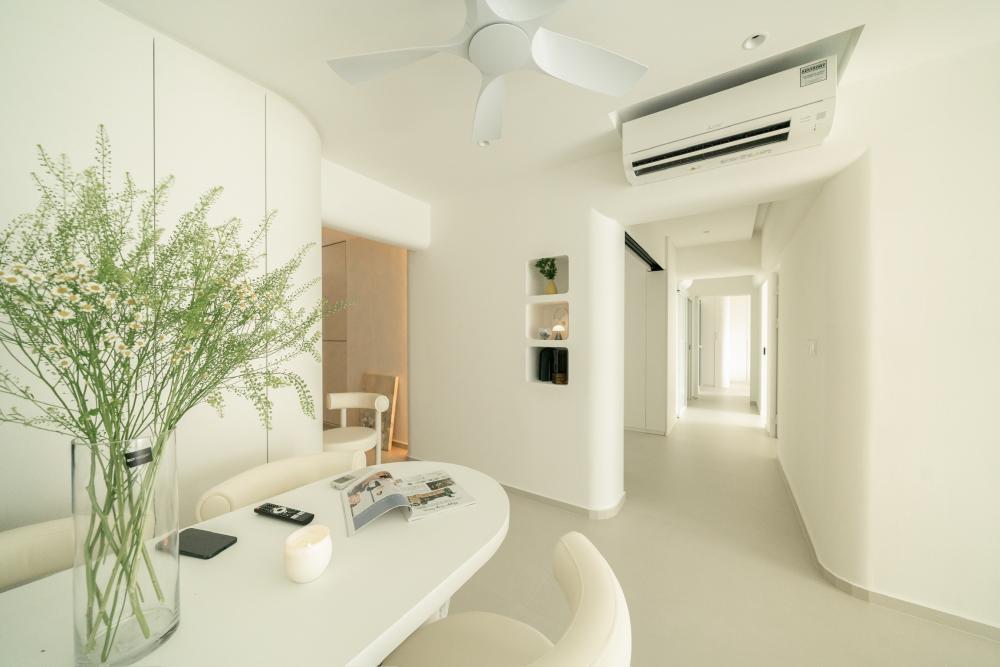

Tampines Green Gem ($85,000) by The Real Design
Minimalism works best for…
Singles or couples without children
For individuals or couples, minimalism is often a natural fit. With fewer possessions, it’s much easier to maintain a clean and organized environment.
Without the need to accommodate children’s toys, books, or personal belongings, creating and keeping a clutter-free space is more manageable. Minimalism provides a stylish, functional backdrop that supports a calm, serene lifestyle, with more flexibility in terms of design choices.
Young professionals
Minimalism is particularly appealing to young professionals who prioritize both aesthetics and practicality. Clean lines, neutral colour schemes, and sleek furniture align well with modern living. Additionally, minimalist spaces are easier to maintain, which is especially important for individuals who lead busy lives and may not have the time to constantly tidy up.
Minimalism is more challenging for…
Families with young children
While minimalism works for some families, it can be harder to maintain in households with young children. Kids often come with a lot of belongings (such as toys, books, art supplies, and clothes) that are hard to keep out of sight.
With kids, the need for organization and storage solutions increases, and it can be challenging to maintain a clutter-free, minimalist home when the space is filled with these necessities. Additionally, young children can be rough on furniture, and minimalistic designs that use delicate or easily damaged materials may not be practical.
Multi-generational households
In homes with multiple generations, including elderly parents or grandparents, minimalist design can sometimes clash with the comfort and practicality that older family members may prefer.
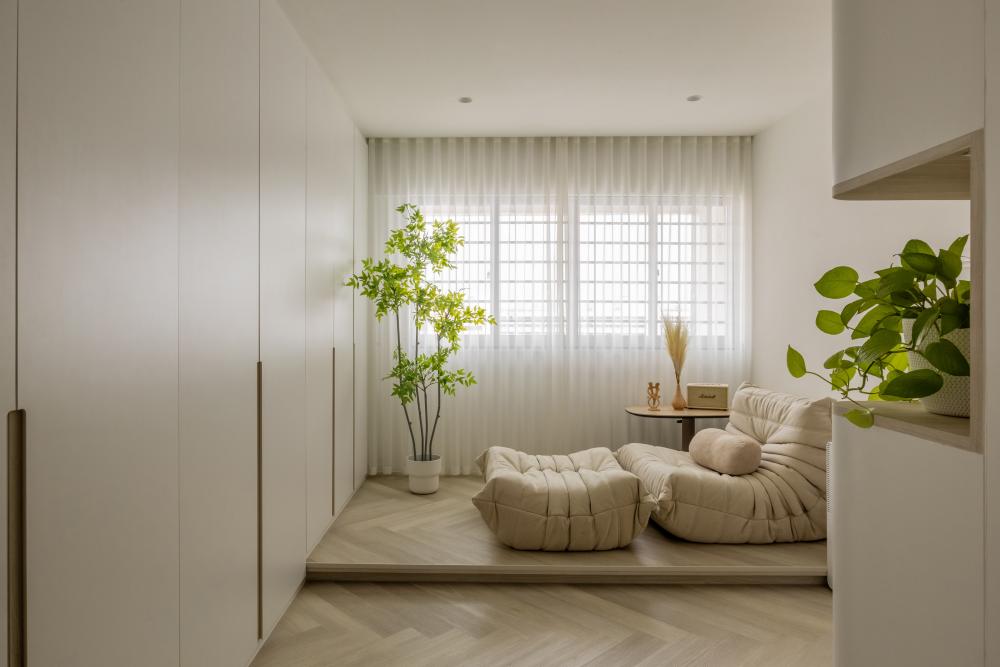

414 Hougang Avenue ($73,000) by Renologist
For elderly members, furniture with supportive features like armrests or padded cushions may be essential. Minimalism, with its emphasis on sleek lines and less furniture, may not always meet these needs, making it harder to find the right balance.
Making minimalism work for families of all sizes
While minimalism can be challenging for larger or multi-generational families, it can still be adapted to suit the needs of every household. Here are a few strategies:
- Look for storage solutions that allow you to hide toys, books, and other items out of sight. Custom built-in shelves, under-bed storage, and multi-purpose furniture like storage ottomans are great ways to keep things organized while maintaining a minimalist aesthetic.
- Kids can be messy, so opt for materials that are easy to maintain. Choose stain-resistant fabrics for furniture and washable rugs, and consider scratch-resistant surfaces for kitchen counters and tables. These practical choices ensure your minimalist design stays intact without compromising on functionality.
- In a multi-generational home, it’s important to balance minimalist design with the need for comfort. Consider incorporating traditional or comfortable furniture pieces like plush sofas or armchairs alongside minimalist decor to cater to the comfort needs of elderly family members.
- Integrate accessibility features like grab bars, softer lighting, or sturdy, supportive furniture. You can still maintain a minimalist approach by selecting clean lines, neutral colours, and simple, uncluttered designs while ensuring that the space is safe and comfortable for all generations.
Planning Your Minimalist Renovation
A minimalist renovation requires thoughtful planning to ensure simplicity, functionality, and efficiency. Here’s how to approach it:
Figure out what you truly need
Minimalism is about simplifying your environment by focusing on what truly matters. Start by evaluating your possessions and identifying the essential items that add value to your life. Consider what you truly use, need, and love, and make a conscious effort to declutter. This means letting go of unnecessary belongings that don’t serve a functional or emotional purpose.
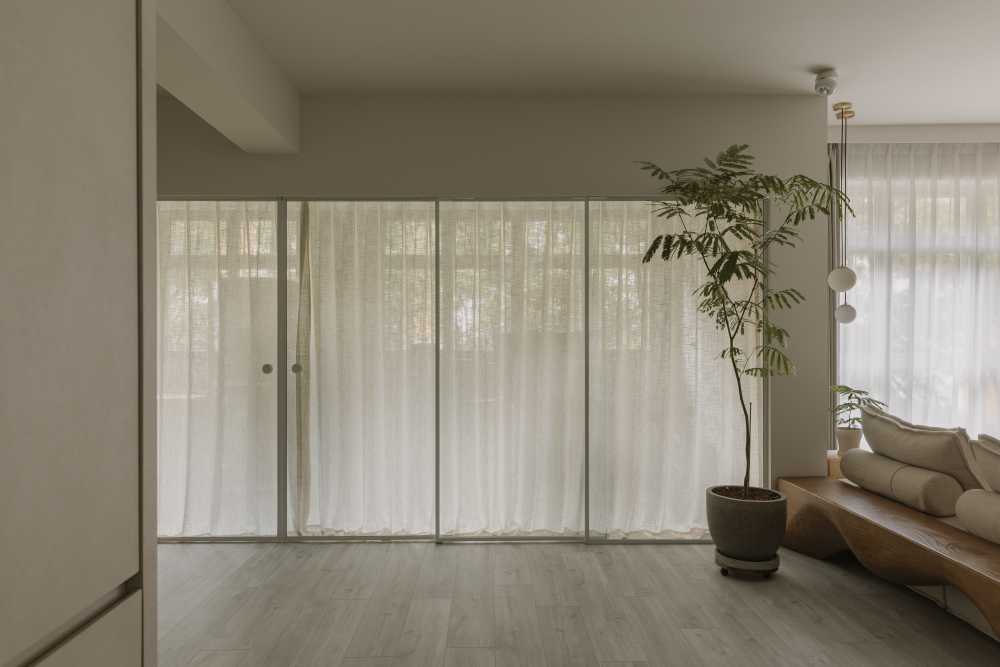

9 Joo Seng Road 2 ($95,000) by The Interior Lab Pte Ltd
By clearing out the excess, you’ll create space for what truly enhances your life and supports your minimalist vision.
Focus on quality, not quantity
In minimalist design, every item should serve a purpose and contribute to the overall aesthetic. Prioritize high-quality materials that stand the test of time, rather than opting for a large number of cheaper items. Choose timeless, versatile furniture and fixtures that can withstand wear while maintaining a clean, uncluttered look.
Consider an open layout
Open floor plans are a hallmark of minimalist design, allowing spaces to feel larger, more airy, and interconnected. Consider removing walls or barriers between living, dining, and kitchen areas to create a seamless flow.
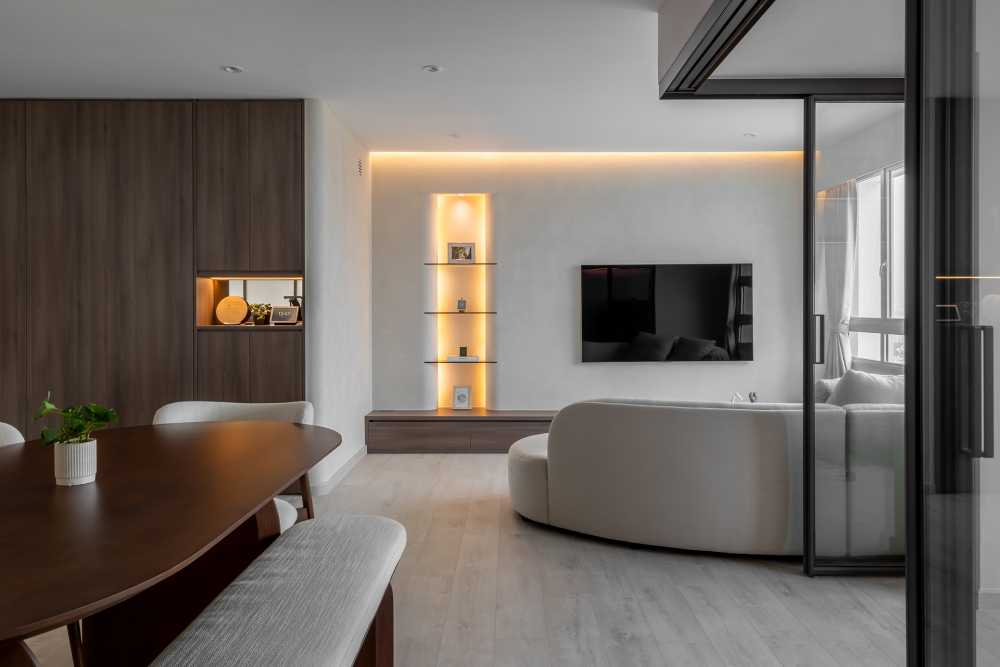

Resale 4-Room HDB at Ang Mo Kio ($82,000) by Space Atelier Pte Ltd
This helps maintain the spacious, uncluttered feel central to minimalist living. When designing your open layout, ensure that traffic patterns are clear and that spaces are well-defined, even without walls.
Plan for practical storage solutions
A key element of minimalist design is maintaining a clean and tidy space, which often means having hidden or integrated storage. Consider built-in cabinets, wall-mounted shelving, or multifunctional furniture to keep clutter out of sight. Think about how your family’s needs will evolve over time and design with adaptability in mind.
Embrace neutral tones and simple lines
When planning your colour palette, stick to a neutral palette with clean lines and subtle textures to create a serene environment. Avoid overly decorative features or patterns that could distract from the overall simplicity. Incorporate natural materials like wood or stone to bring warmth and texture into the space without adding visual clutter.
Minimalist Storage Solutions
As we’ve mentioned, minimalism thrives in spaces that are clean, organized, and clutter-free. To maintain this balance, smart storage solutions are essential. Here are some strategies to keep your space functional and minimalist:
Built-in cabinets
These provide seamless storage while maintaining a clean, uncluttered look. Custom-built cabinetry can be designed to blend in with the walls, helping to hide away everything from everyday essentials to larger items like coats, shoes, or electronics. Consider floor-to-ceiling cabinets for maximum storage potential, making full use of vertical space without disrupting the minimalist aesthetic.
Multifunctional furniture
When space is limited, multifunctional pieces are a game-changer. Look for beds with hidden storage drawers or sofas that double as a guest bed. Foldable dining tables or wall-mounted desks can be tucked away when not in use, saving space while providing functionality when needed. Investing in versatile furniture ensures that every item serves multiple purposes without cluttering your home.
Multifunctional spaces
Think beyond furniture – sometimes your whole space can serve dual purposes.
For example, a concrete ledge beneath the TV can function as a place to store your soundbar, electronics, or décor items. But by designing it long and wide enough, it can also double as extra seating for guests when needed. This creates a flexible environment where surfaces and spaces can serve multiple functions without taking up extra room.
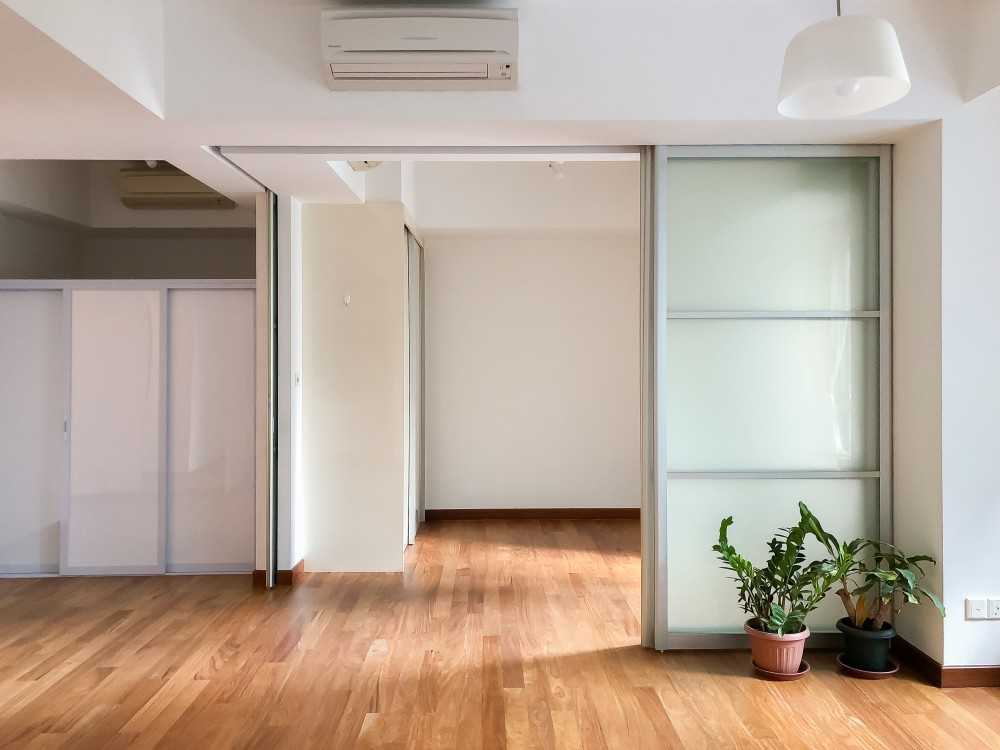

The Sail at Marina Bay ($78,000) by Alexis Interior Pte Ltd
Another example is using fold-away doors or partitions. These can be installed between your living room and study, allowing you to open them up when entertaining, creating a larger, more open space. When not in use, simply close the partitions to maintain a more defined, private area.
Wall-mounted shelving
Open shelving is a great way to display only the items you use and love, while keeping floors clear and creating vertical storage. In eclectic spaces, open shelves are styled with a mix of textures and colours. However, in minimalist spaces, the key is restraint. Here are some tips:
- Don’t crowd the shelves. Leave some breathing room between objects for a clean, uncluttered look.
- Choose items in a consistent colour scheme, such as neutral tones or soft pastels, to keep the look cohesive and calm.
- Curate thoughtfully, and display only a few meaningful items to maintain simplicity and avoid overcrowding.
Hidden storage in furniture
Many minimalist homes integrate hidden storage into their furniture. Coffee tables with storage compartments, ottomans that double as footrests or seating, or even armchairs with hidden drawers provide discrete spaces for storing everyday items without compromising design.
Under-bed storage
The space beneath your bed can often go underutilized. Storage bins or drawers under the bed can hold extra bedding, clothes, or seasonal items. Opt for low-profile bins or furniture with built-in drawers to maintain a sleek, tidy look.
Designing Key Areas in Minimalist Style
Minimalism is all about embracing simplicity and functionality while creating a calm, clutter-free environment. Here’s how to bring minimalism to different parts of your home:
Living room
For a minimalist living room, focus on clean, streamlined furniture with simple shapes. Choose pieces with hidden storage to keep clutter out of sight and opt for neutral tones to create a calm, inviting atmosphere. Hide cables and wires to maintain clean lines and prevent distractions.
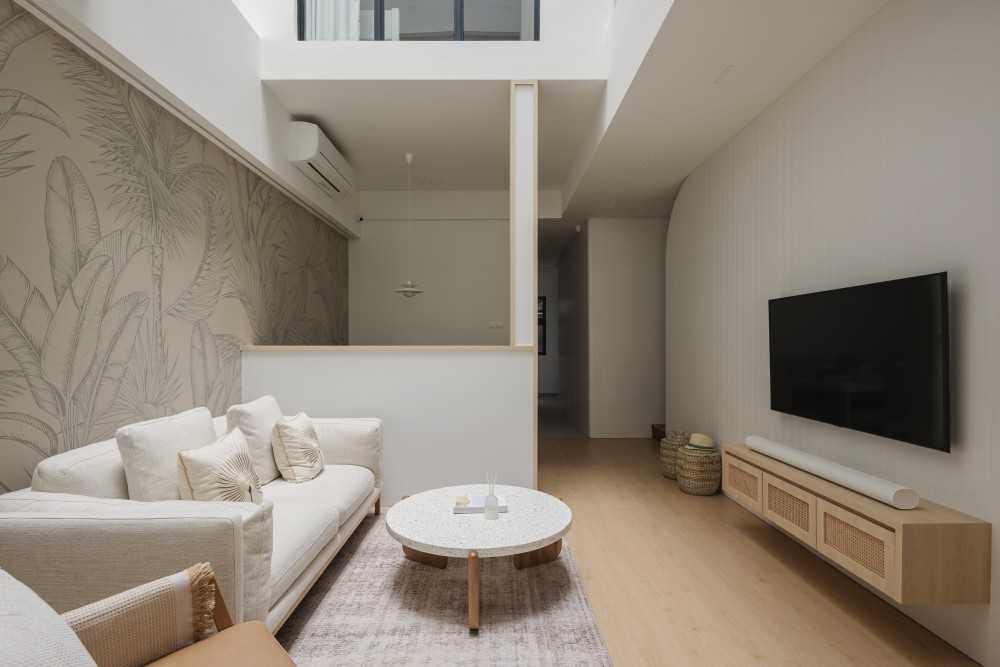

Mangis Road ($86,000) by The Interior Lab Pte Ltd
Instead of overcrowding with decor, highlight one or two statement pieces, such as a unique coffee table, a striking piece of artwork, or an accent chair. Use subtle textures, like soft rugs or throws, to add warmth without overwhelming the space.
Bathroom
In the bathroom, embrace minimalism with frameless mirrors and minimal hardware. Choose wall-mounted fixtures, such as faucets and towel bars, to create a sense of space and reduce visual clutter. Opt for sleek, streamlined storage solutions like floating vanities or hidden compartments to store toiletries.
For a clean look, stick with simple tiles and soft, neutral colours for a spa-like feel. Open shelving can work in the bathroom if you keep it minimal, displaying only a few neatly arranged items like towels or plants.
Kitchen
Minimalist kitchens are all about functionality and sleek design. Install handle-less cabinetry for a seamless, modern look and choose integrated appliances that blend into the cabinetry to maintain clean surfaces. Keep the backsplash simple – opt for large-format tiles or a solid colour to avoid visual clutter. Store as much as possible out of sight to maintain open counters.
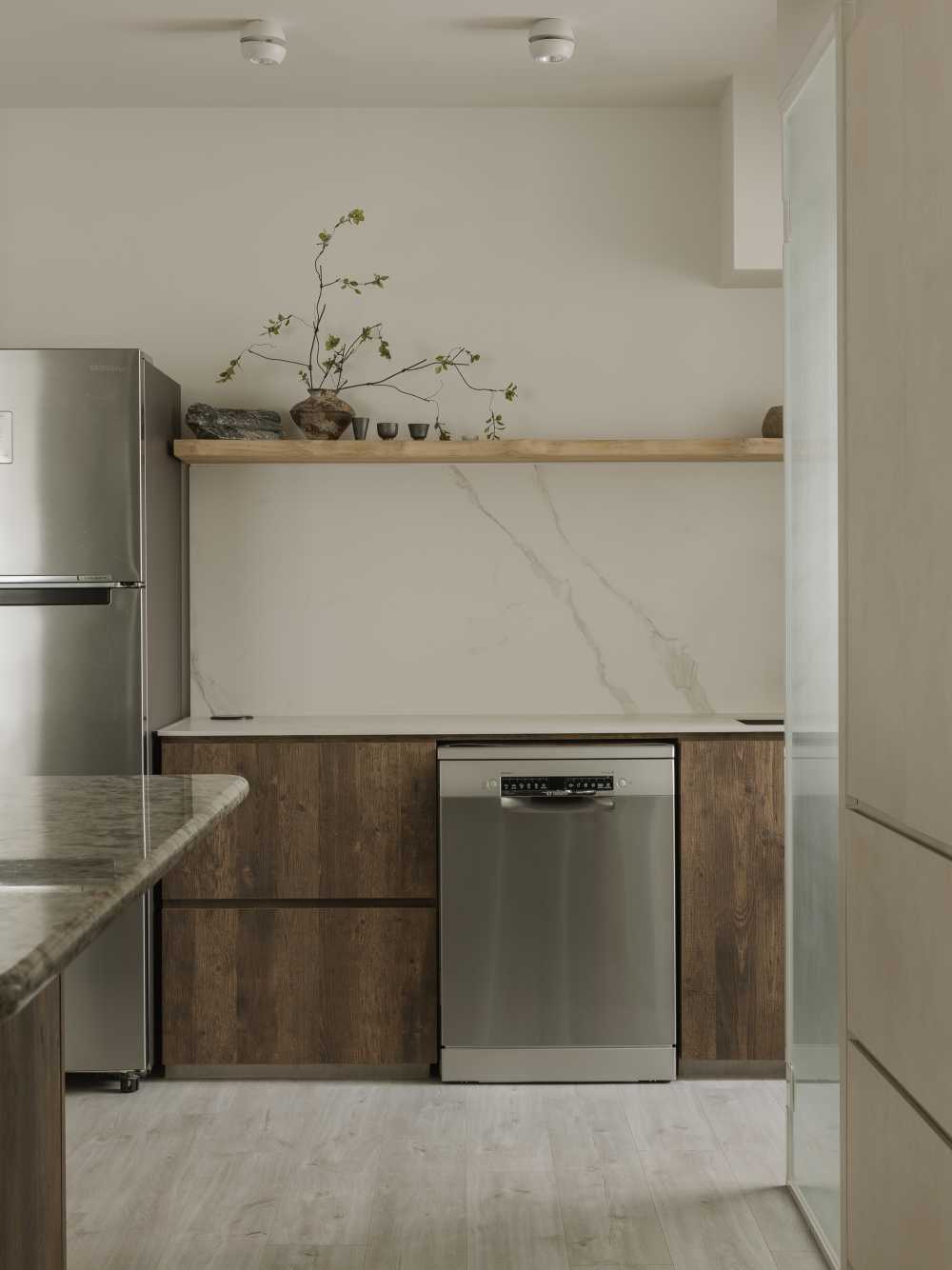

9 Joo Seng Road 2 ($95,000) by The Interior Lab Pte Ltd
If possible, create hidden pantry spaces or use pull-out cabinets to keep essentials out of view, allowing the kitchen to feel both stylish and functional.
Bedroom
A minimalist bedroom is all about comfort and simplicity. Choose a low-profile bed frame with clean lines and keep the bedding monochromatic or in muted tones for a restful atmosphere.
Eliminate unnecessary decor, focusing on essentials like a statement light fixture or a couple of carefully chosen decorative items. Keep the space free of excess furniture—opt for built-in or under-bed storage to minimize clutter. A simple, clutter-free environment promotes relaxation, making your bedroom a peaceful retreat.
Incorporating Technology for Minimalist Living
Technology can be a powerful ally in creating a minimalist home, enhancing both aesthetics and functionality. By integrating smart devices and space-saving appliances, you can reduce clutter and maintain the clean, sleek lines that define minimalist design.
Smart home devices
Embrace smart home technology to eliminate the need for visible switches, remotes, and extra gadgets. Smart lighting systems, such as voice-controlled or app-controlled lights, allow you to adjust ambiance without the clutter of physical switches. Similarly, automated blinds or curtains can provide convenience while maintaining a clean, modern look.
Space-saving appliances
Choose appliances that combine functions to save both space and time. For example, combination washer-dryers and built-in dishwashers are perfect for small kitchens, reducing the number of separate units while still providing full functionality. In the bathroom, wall-mounted or compact versions of appliances like hairdryers or electric toothbrush chargers keep surfaces clear and tidy.
Wireless technology
Wireless speakers, charging stations, and Bluetooth-enabled devices eliminate the need for visible cables and wires, contributing to a more streamlined look. Wireless charging pads can replace bulky charging stations, while smart speakers provide both entertainment and home control without the clutter of multiple devices.
Common Pitfalls in Minimalist Renovations
When it comes to minimalist renovations, it’s easy to get caught up in the aesthetic allure of the style. However, to truly embrace minimalism, it’s important to avoid these common pitfalls:
Overemphasizing aesthetics
While minimalist design often looks sleek and beautiful, it’s important not to prioritize aesthetics over practicality. The goal of minimalism is to create spaces that are functional as well as visually appealing.
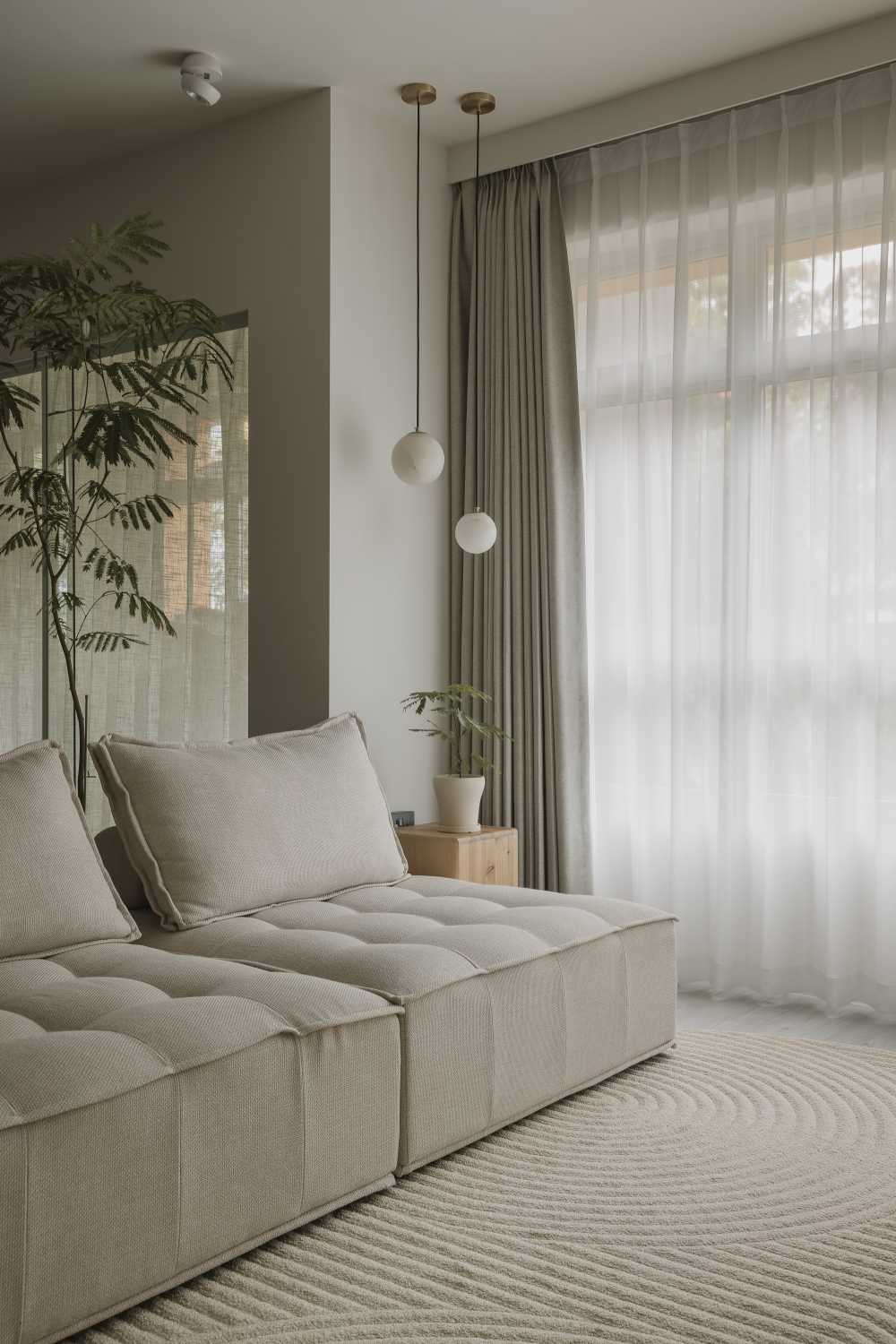

9 Joo Seng Road 2 ($95,000) by The Interior Lab Pte Ltd
Don’t overlook the need for storage, comfort, or ease of use just for the sake of a “picture-perfect” look. For example, open shelving can look great, if it’s not functional and doesn’t suit your lifestyle. it could backfire. Make sure each design decision serves both form and function.
Choosing low quality pieces
Minimalist spaces often revolve around fewer, more thoughtfully chosen items. Since these items play such a crucial role in your space, it’s essential to select high-quality, durable pieces. Cheap or poorly made furniture might look similar to what you see in minimalist spaces, but over time, it will wear down and detract from the clean, sleek look you’re going for.
Opt for well-crafted, timeless pieces that can withstand daily use while maintaining their aesthetic appeal. Quality over quantity is key – buy fewer items, but make them count.
Misinterpreting minimalism as cheap
As we discussed earlier, it’s a common misconception that minimalist design is synonymous with budget-friendly or cheap. Minimalism isn’t about cutting costs, but about focusing on essential elements that serve a clear purpose.
Striving for simplicity doesn’t mean sacrificing quality or skimping on design. In fact, minimalism often demands higher-quality materials and custom-built pieces that enhance the space’s functionality and longevity. Instead of looking for the least expensive options, aim for well-designed, durable items that offer long-term value. The focus should be on intentional simplicity, not just on cutting corners to save money.
Neglecting personal touches
While minimalism is about reducing visual clutter, it doesn’t mean your home has to feel impersonal or sterile. Avoid the mistake of stripping away all personality in the name of simplicity.
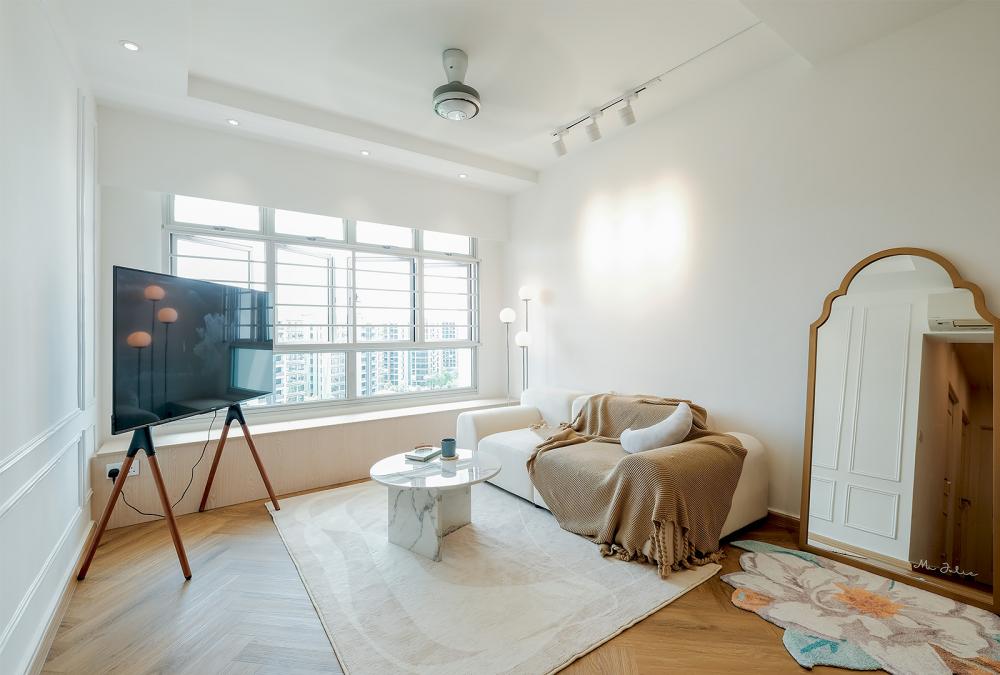

526D Pasir Ris ($88,000) by Elique
Minimalist design can still reflect your style by thoughtfully incorporating a few meaningful, personal items – like a piece of artwork, a cherished object, or a family heirloom – into the space. These personal touches help your home feel inviting and unique, rather than cold and lifeless.
Budget-Friendly Tips for Minimalist Renovations
With a bit of planning and thoughtful choices, you can create a space that feels serene, stylish, and sophisticated on a budget. Here are a few tips to help you design a minimalist home that looks high-end, without compromising on quality or style.
Prioritize key areas
When working with a budget, focus on areas that have the most impact on the overall look and feel of the space. This might be the living room or bedroom where you spend most of your time.
Instead of spreading your budget too thin across every room, dedicate more resources to these high-traffic spaces, investing in quality essentials like furniture, lighting, or decor that will set the tone for the rest of the home. For example, invest in a well-made sofa or a statement dining table to anchor your main living area, and leave less expensive accents for other spaces.
Invest in high-quality pieces
Minimalism is about quality, not quantity. Invest in a few standout, high-quality pieces that will last and serve you well over time. Look for furniture made from durable materials like solid wood, and choose brands that offer warranties or guarantees on their products.
For example, some stores in Singapore offer lifetime warranties on wood furniture like dining tables, bedframes, and chairs, ensuring that your investment will last for many years. This ensures that your pieces retain their value and contribute to the overall timeless aesthetic of your minimalist space.
Minimalist lighting
Lighting is one of the easiest ways to make a space feel elegant and minimalist. Instead of overcrowding a room with numerous light sources, focus on a few well-designed fixtures that blend seamlessly with the space.
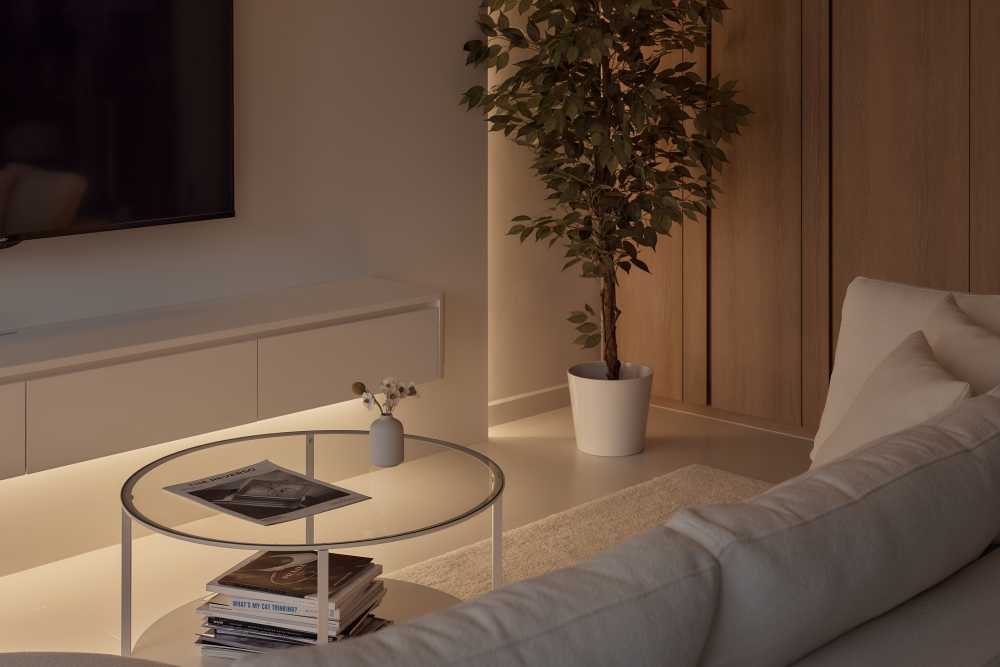

Clementi Peaks 4 ($99,000) by Starry Homestead Pte Ltd
Opt for simple, sleek designs in materials like matte metal or glass to keep the space feeling open and airy. Ceiling lights or pendant lights with clean lines create a modern, uncluttered vibe. Consider smart lighting systems to reduce the number of visible switches and remotes, helping to keep surfaces and spaces free from distractions.
DIY projects
If you have DIY skills, consider tackling projects like limewashing walls – but only if you can do it well! Minimalism is about simplicity and elegance, so it’s important that DIY elements blend seamlessly into the space and don’t appear obviously homemade.
While DIY projects can help you save money and personalize your design, they should complement the clean, refined aesthetic of minimalism, rather than disrupting it with visible imperfections.
The power of styling
Styling is a key component in bringing the minimalist look to life. Properly styled spaces will lean into the minimalist ethos, making the space feel elegant without overwhelming it.
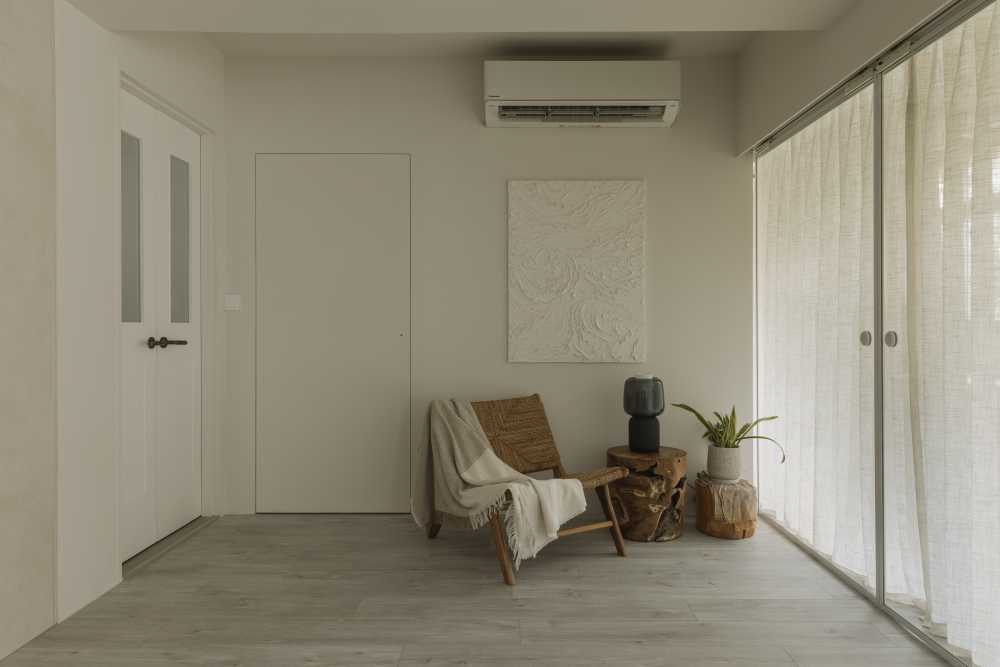

9 Joo Seng Road 2 ($95,000) by The Interior Lab Pte Ltd
For example, framed black-and-white photographs or simple, neutral-coloured art are both affordable and add sophistication to your home. However, loud, colourful artwork can quickly disrupt the calm, understated vibe of a minimalist design. Stick to a cohesive colour palette and embrace simplicity in your decor to ensure that every piece serves a purpose and contributes to the overall aesthetic.
Maintaining Your Minimalist Home
Maintaining a minimalist home goes beyond design; it’s about developing habits and mindsets that align with simplicity and intentional living. By incorporating daily routines and periodic decluttering, you can keep your space feeling clean, organized, and purposeful.
Here are some strategies to help you live a minimalist lifestyle every day:
Daily habits
To preserve the minimalist aesthetic, establish daily routines that prevent clutter from accumulating. Regularly clear surfaces such as countertops, coffee tables, and desks to keep your home feeling organized and open. Make it a habit to return items to their designated spots after use, whether it’s a book on a shelf, a pair of shoes in the closet, or a mug in the kitchen.
This small effort can make a huge difference in keeping your space tidy and free from unnecessary items.
Periodic decluttering
Minimalism thrives on intentionality, and part of this is regularly reassessing your belongings. Every few months, take a critical look at your possessions. Do they still serve a purpose, both functionally and aesthetically? If something no longer fits your needs or your minimalist vision, consider donating, selling, or recycling it. This ongoing process ensures your space doesn’t get weighed down by items that no longer align with your lifestyle.
Mindset shift
Embrace the “less is more” philosophy not just in your home’s design but also in your daily life. Shift your focus from accumulating material possessions to prioritizing experiences, relationships, and meaningful items.
This mindset helps reduce the impulse to buy things you don’t truly need, and instead, fosters a deeper connection with the items you own. By being mindful of the impact of your purchases and focusing on quality rather than quantity, you can ensure that your home and life remain simple, sustainable, and intentional.
A Final Word on Renovating In the Minimalist Style
Renovating your home in the minimalist style can transform it into a serene and timeless sanctuary.
While minimalism isn’t for everyone, it offers an elegant and practical solution for Singapore homes, especially for singles and couples. By focusing on simplicity, functionality, and intentionality, you can create a space that reflects your values and enhances your everyday life.
Want to check out home renovation projects for more inspiration? Browse minimalist design ideas on Hometrust, or click the button below to get connected with expert designers!
Renovating soon? Let Hometrust recommend the best interior designers.
If you are reading this, you are probably wondering how you can create your dream home.
Here’s the thing, everyone’s needs and requirements for their home renovation is different. A designer that may work for someone else, may not quite work for you.
At Hometrust, we’re here to help match top rated designers, recommended by past homeowners to you through our data-driven and matching algorithm.
Whether you are looking for partial renovation or a full fledge overhaul, we’ll be able to recommend you top designers to match your renovation requirements and lifestyle.
Recommendations and free and you can simply start by helping us understand your needs below!
Get RecommendationsRenovate safe!
The Hometrust Team

